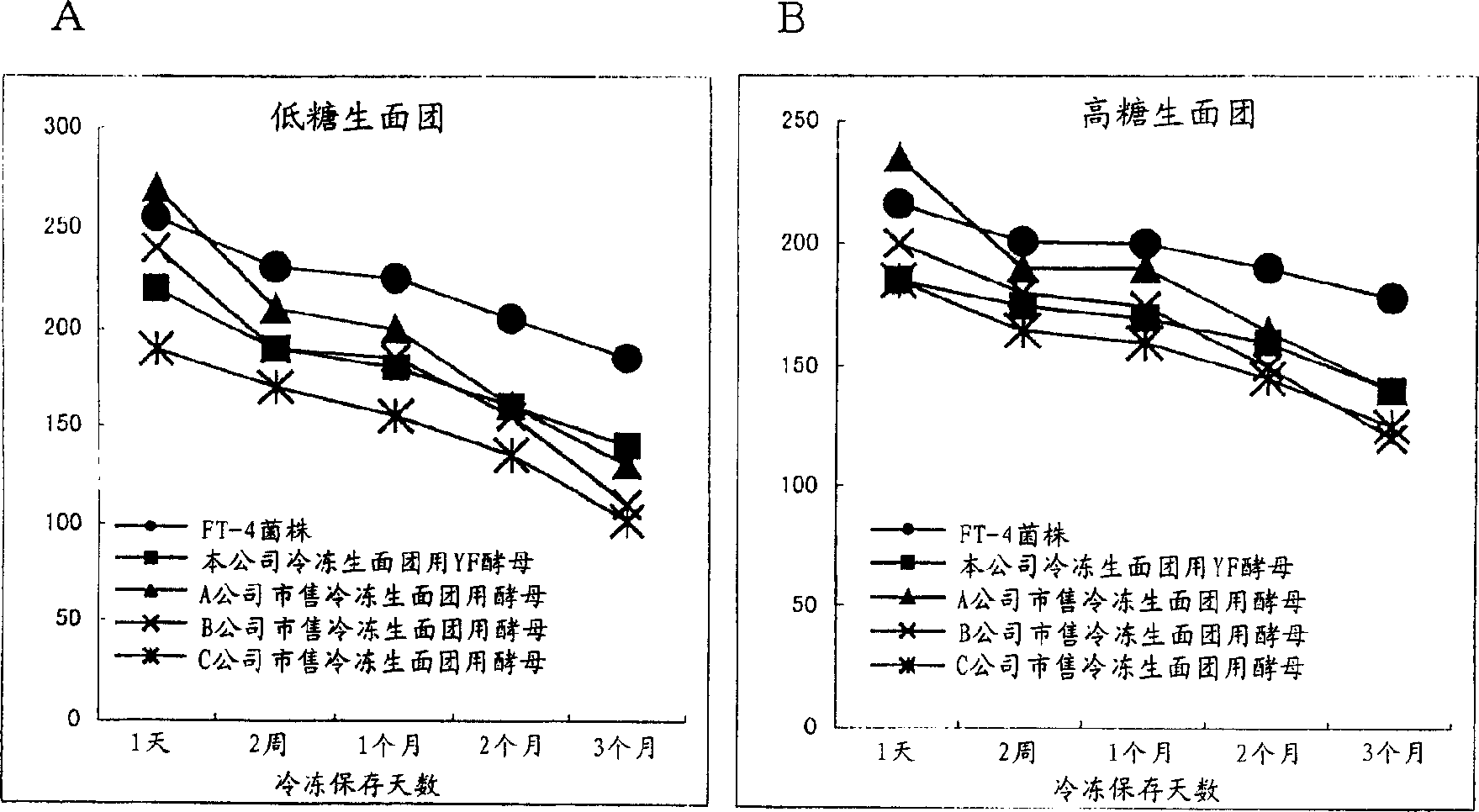Bread yeast and bread therewith
A technology of baker's yeast and yeast, applied in application, dough preparation, pre-baked dough processing, etc., can solve the problems of destroying bread flavor, unsatisfactory bread flavor, and masking aroma, etc., and achieve the effect of excellent flavor
- Summary
- Abstract
- Description
- Claims
- Application Information
AI Technical Summary
Problems solved by technology
Method used
Image
Examples
Embodiment 1
[0032] Example 1 Breeding and Screening of Saccharomyces cerevisiae FT-4 Strain
[0033] Haploid yeast strains are obtained by germinating the spores of diploid yeast strains belonging to Saccharomyces cerevisiae (our company’s YF yeast) that have at least strong freezing resistance, so that they do not have freezing resistance, but are peculiar to yeasts. A haploid yeast strain is obtained by germinating the spores of a weak diploid yeast strain of S. Somatic yeast strains.
[0034] Next, these strains were screened for freezing resistance. Put 3ml of YPD liquid medium into a 13ml test tube, sterilize at 120°C for 15 minutes, use an inoculation loop to inoculate various strains, and culture at 30°C for 20 hours with shaking. The obtained bacterial cells were centrifuged at a speed of 3000 rpm for 15 minutes and collected, washed twice with cold water to collect the bacterial cells. Add 3ml of LF medium (dilute 10g of glucose, 30g of maltose, and 30g of sucrose to 1L with...
Embodiment 2
[0039] Select 4 strains that meet the above conditions and obtain good results in the bread-making test, and name one of them as Saccharomyces cerevisiae FT-4 strain. Example 2 Comparison of isobutyric acid content
[0040] Using an inoculation loop, FT-4 strain and baker's yeast from each company were inoculated with 100 ml of YPD liquid medium in a 500 ml Erlenmeyer flask with a stopper, and cultured at 30° C. for 20 hours with shaking. The culture solution was centrifuged at a speed of 3000 rpm for 5 minutes, and after the bacteria were collected, they were washed twice with sterilized distilled water, and the obtained washed cells were freeze-dried. Cold water was added to the freeze-dried bacterial cells to adjust the solid content to 20%, and then 10% glass beads were added, and the bacterial cells were pulverized by high-speed stirring with a vortex. After performing centrifugation at a rotation speed of 10000 rpm for 10 minutes, the isobutyric acid content of the sup...
Embodiment 3
[0043] Example 3 Non-frozen dough leavening activity
[0044] Using the FT-4 cells cultured in a 300L fermenter, the fermentation activity of non-frozen dough was measured by the Yeast Industry Association method according to the following procedure.
[0045] ·Cultivation of FT-4 strain beads
[0046] (1) Used for the cultivation of yeast species
[0047] Using an inoculation loop, inoculate FT-4 strain with 200ml YPD liquid medium in a 500ml Erlenmeyer flask with a stopper, shake at 30°C for 24 hours to obtain a culture medium, and inoculate the resulting culture medium into a 30L fermenter The 15L molasses culture medium (referring to Table 4), under the condition shown in Table 4, make the yeast species that 300L fermentor is used for cultivation.
[0048] (2) 300L fermenter culture
[0049] In a 300L fermenter, after adjusting 150L of the medium of the present invention shown in Table 4, all the yeast species cultured in the 30L fermenter were inoculated and cultured ...
PUM
 Login to View More
Login to View More Abstract
Description
Claims
Application Information
 Login to View More
Login to View More - R&D
- Intellectual Property
- Life Sciences
- Materials
- Tech Scout
- Unparalleled Data Quality
- Higher Quality Content
- 60% Fewer Hallucinations
Browse by: Latest US Patents, China's latest patents, Technical Efficacy Thesaurus, Application Domain, Technology Topic, Popular Technical Reports.
© 2025 PatSnap. All rights reserved.Legal|Privacy policy|Modern Slavery Act Transparency Statement|Sitemap|About US| Contact US: help@patsnap.com


